Chenglong Village (成龍村) doesn’t sound like a likely place for an art exhibition. This small fishing village of around 1,000 people is located in one of the nation’s poorest areas, Yunlin County, and it lacks many of the modern conveniences of a city.
But this is what makes Chenglong interesting to American artist Jane Ingram Allen, who is the curator of the Cheng Long Wetlands International Environmental Art Project (成龍濕地國際環境藝術節), an exhibition that opens in the village tomorrow.
“It’s almost like stepping back in time when you come here,” she said. “There’s no 7-Eleven, there’s no Starbucks, there’s no restaurant, there are no hotels. It’s a simple life, but the people seem happy.”
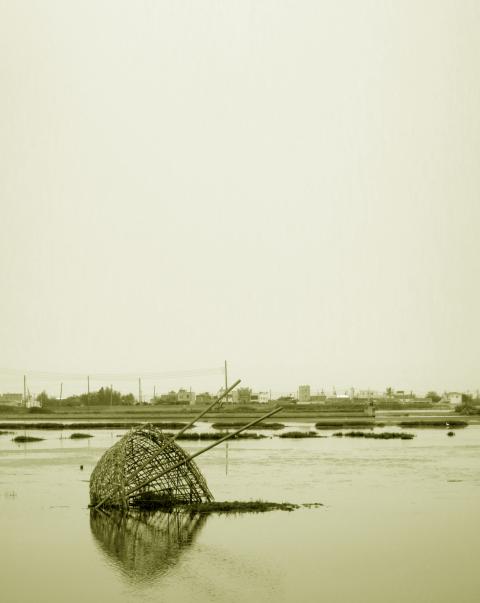
Photo courtesy of Jane Ingram Allen
And it turns out that Chenglong is well-suited for an exhibition of “environmental art.” The village is home to the Chenglong Wetlands (成龍溼地), an area of land on Taiwan’s southwest coast that locals have been maintaining as a nature preserve.
Chenglong is also abundant in materials that have been “recycled” to create the six installation pieces that will be displayed outdoors in the wetlands area. Visitors will see works made out of clam shells (fish, shrimp and clam farming are major sources of income for the village), banana leaves, grassy reeds, bamboo, and even plastic bags.
The project that Allen is overseeing is part of a program by the Kuan Shu Education Foundation (觀樹教育基金會), a non-governmental organization devoted to environmental education. For the past three years, the foundation has been working with Chenglong Elementary School (成龍國小) to teach students about the wetlands and its preservation.
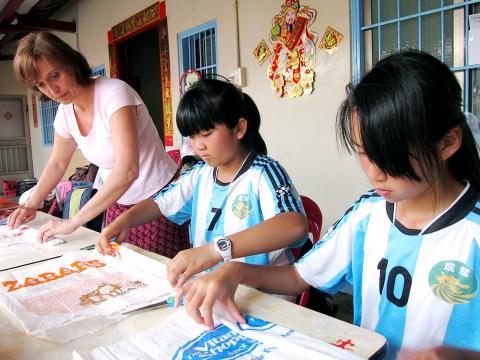
Photo courtesy of Jane Ingram Allen
The school’s 77 students, along with a number of village residents, are also active participants in the Environmental Art Project, which is also in its third year. The students and some village residents helped the eight visiting artists to collect raw materials and construct the art displays. The Chenglong residents also had the chance to become well acquainted with the artists, who came from places as far flung as South Africa and India and stayed in the village for one month.
Allen chose the artists out of a pool of 180 people, partly based on their experience and interest in using recycled and natural materials. (Allen is a paper-maker and sculptor who focuses on environmental art in her own work).
The theme of this year’s exhibition is titled What’s for Dinner?
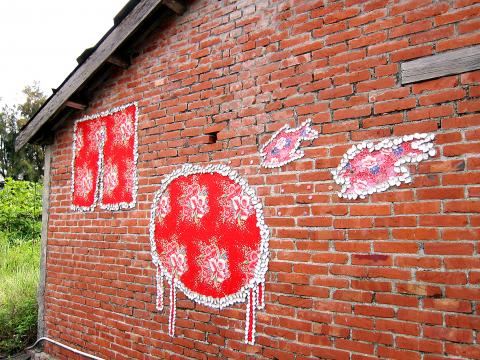
Photo courtesy of Jane Ingram Allen
“We wanted to emphasize seafood production because it’s the main industry in this area,” said Allen. “[We want] to get people to think about where their food comes from and where it’s produced.”
Markuz Wernli of Switzerland and Madoka Yoshitomi of Japan created Food Chain, a mosaic mural made of discarded clam shells located at the roadway entrance to Chenglong Wetlands. The pair enlisted the help of fifth graders from Chenglong Elementary School to collect shells from local clam farmers, but some of the material came from Taipei. Before arriving, Wernli visited some night markets in the capital, passing out flyers that explained his work and asked people to send their empty shells to him. Several obliged, sending him shells by post.
Another work, Invasive Species by Isabelle Garbani, suggests a commentary on our excessive use of plastic bags. The Brooklyn, New York-based French artist, with help from local sixth graders and residents, collected plastic bags, cut them into strips and crocheted them (a stitching technique similar to knitting that uses a hooked needle). She and her helpers made hundreds of leaves, which cover an abandoned house and look like ivy invading a building.
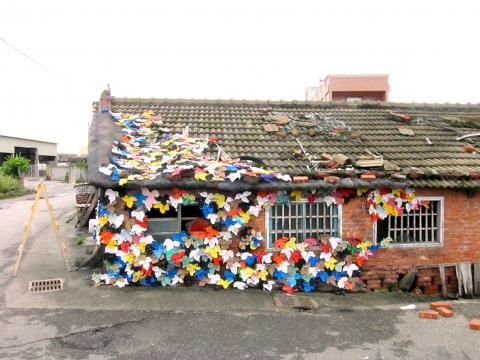
Photo courtesy of Jane Ingram Allen
Two installations are displayed in the marshes of Chenglong Wetlands. South African Janet Ranson’s Cycle of Life is a group of sculptural poles depicting the relationship between plant and animal life. Prashant Jogdand of India made a life-sized Food Bowl and Spoon from salvaged bamboo.
Two Taiwanese artists have drawn a more direct connection to village life. Hsu Yen-ting (許雁婷) spent the past month with clam and fish farmers, recording sounds and collecting oral history, which she plays in a sound art installation in an abandoned house. Yvonne Chiu (邱禹鳳) worked with Chenglong Elementary School students to make stop-motion animation films about family dinners and, of course, seafood.
Allen says these installation works don’t intend to dramatically change people’s views on environmental conservation, but rather get the point across in a “gentle” way.
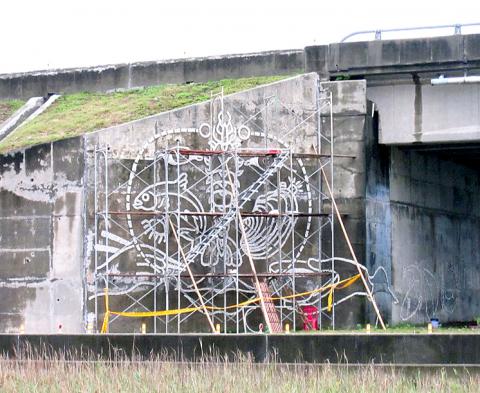
Photo courtesy of Jane Ingram Allen
Yet the project’s very location draws attention to local environmental issues. The Chenglong Wetland area was once farmable land, but over past decades, sea water floods eventually made it impossible for residents to continue growing staple crops such as rice and sweet potato. And like other coastal areas in Yunlin County, Chenglong Village is plagued by land subsidence problems. According to Yunlin County Government statistics cited by the Kuan Shu Education Foundation, the area around Chenglong Village has been sinking by at least 3.1cm a year. (Allen describes part of the landscape at the wetlands as “submerged homes, graves, telephone poles and temples.”)
The blame for the area’s sinking land has been placed on local industries such as fish farms, which require massive amounts of groundwater. But locals have countered that seafood farming is an economic necessity since there isn’t enough land suited for growing plant crops. To this end, Kuan Shu also runs a program that teaches local residents about sustainable farming practices. “We want to show them it’s possible to grow food [including fish farming] without pumping underground water,” said foundation director Wang Chao-mei (王昭湄).
As for the children, Kuan Shu’s education program is helping foster an appreciation for the wetlands, says Chenglong Elementary School principal Hsu Hung-nan (許宏男). “Nowadays, when they walk around the wetlands, they can identify [many of the area’s 80 or so] bird species.”
And the art project has given the Chenglong students something to look forward to every March, when a new set of artists arrive. Hsu says this year, the students were excited and “full of anticipation” about meeting new visitors from abroad.
Allen says it wasn’t like this when she first arrived three years ago, as many of the village residents had probably “never seen a foreigner up close.”
“But now, it’s just completely transformed, the villagers and the school,” she said. “Now they see the wetlands as a positive thing, and it’s bringing people here, and when you get more people, you have more prosperity.”
The participating artists will be present at the public opening tomorrow and Sunday, offering DIY art activities for visitors.

The unexpected collapse of the recall campaigns is being viewed through many lenses, most of them skewed and self-absorbed. The international media unsurprisingly focuses on what they perceive as the message that Taiwanese voters were sending in the failure of the mass recall, especially to China, the US and to friendly Western nations. This made some sense prior to early last month. One of the main arguments used by recall campaigners for recalling Chinese Nationalist Party (KMT) lawmakers was that they were too pro-China, and by extension not to be trusted with defending the nation. Also by extension, that argument could be

Aug. 4 to Aug. 10 When Coca-Cola finally pushed its way into Taiwan’s market in 1968, it allegedly vowed to wipe out its major domestic rival Hey Song within five years. But Hey Song, which began as a manual operation in a family cow shed in 1925, had proven its resilience, surviving numerous setbacks — including the loss of autonomy and nearly all its assets due to the Japanese colonial government’s wartime economic policy. By the 1960s, Hey Song had risen to the top of Taiwan’s beverage industry. This success was driven not only by president Chang Wen-chi’s

Last week, on the heels of the recall election that turned out so badly for Taiwan, came the news that US President Donald Trump had blocked the transit of President William Lai (賴清德) through the US on his way to Latin America. A few days later the international media reported that in June a scheduled visit by Minister of National Defense Wellington Koo (顧立雄) for high level meetings was canceled by the US after China’s President Xi Jinping (習近平) asked Trump to curb US engagement with Taiwan during a June phone call. The cancellation of Lai’s transit was a gaudy

The centuries-old fiery Chinese spirit baijiu (白酒), long associated with business dinners, is being reshaped to appeal to younger generations as its makers adapt to changing times. Mostly distilled from sorghum, the clear but pungent liquor contains as much as 60 percent alcohol. It’s the usual choice for toasts of gan bei (乾杯), the Chinese expression for bottoms up, and raucous drinking games. “If you like to drink spirits and you’ve never had baijiu, it’s kind of like eating noodles but you’ve never had spaghetti,” said Jim Boyce, a Canadian writer and wine expert who founded World Baijiu Day a decade